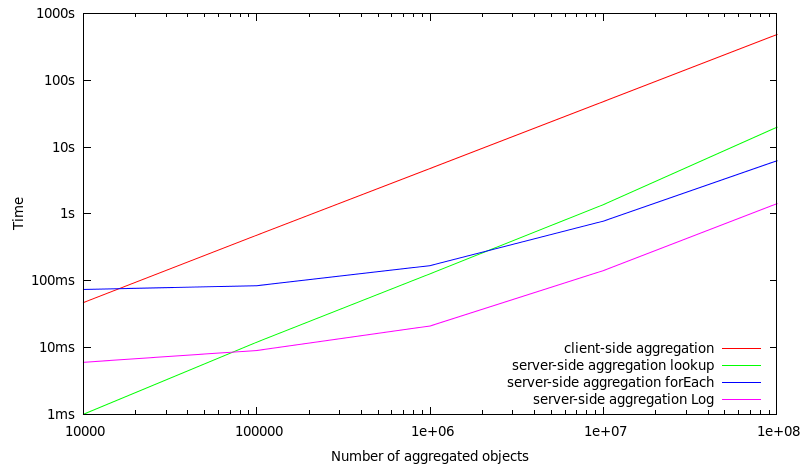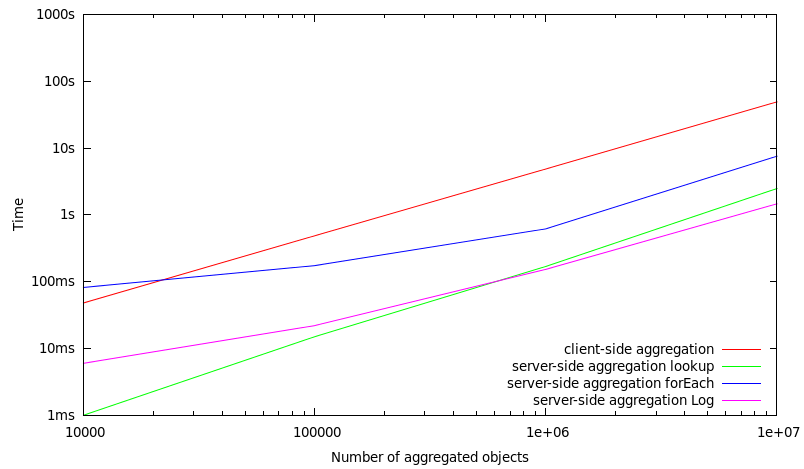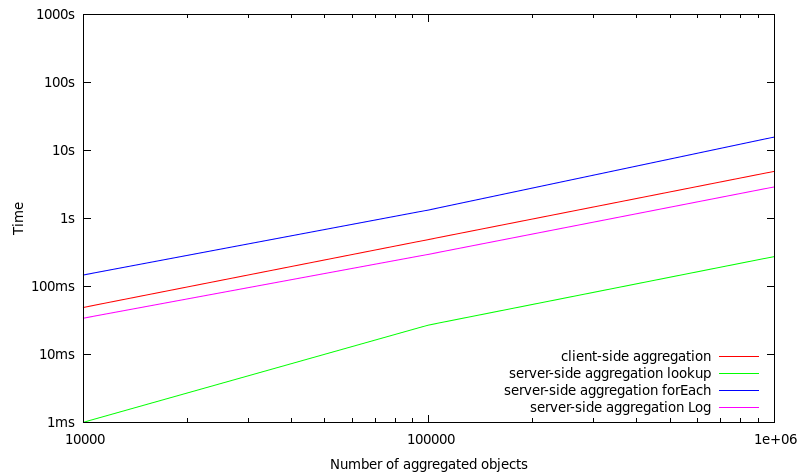...
#number of objects | client-side aggregation | server-side aggregation | server-side aggregation | server-side aggregation |
|---|---|---|---|---|
10.000 | 63 47 ms | 1 ms | 74 ms | 6 ms |
100.000 | 648 480 ms | 12 ms | 84 ms | 9 ms |
1.000.000 | 6485 4790 ms | 127 ms | 168 ms | 21 ms |
10.000.000 | 64258 48127 ms | 1378 ms | 781 ms | 142 ms |
100.000.000 | 652201 485091 ms | 19854 ms | 6245 ms | 1422 ms |
Benchmarks over a subset (10%) of stored objects (high selectivity)
In this set of benchmarks, only a subset of 10% of the objects which are stored in a MasterServer are included in the aggregation operation. Consequently, this means that of if 1.000.000 objects are aggregated, there are 10.000.000 objects stored in total within a MasterServer.
#number of objects | client-side aggregation | server-side aggregation | server-side aggregation | server-side aggregation |
|---|---|---|---|---|
10.000 | 48 ms | 1 ms | 82 ms | 6 ms |
100.000 | 486 ms | 15 ms | 174 ms | 22 ms |
1.000.000 | 4865 ms | 169 ms | 618 ms | 153 ms |
10.000.000 | 49223 ms | 2481 ms | 7565 ms | 1465 ms |
Benchmarks over a subset (0.5%) of stored objects (very high selectivity)
In this set of benchmarks, only a subset of 0.5% of the objects which are stored in a MasterServer are included in the aggregation operation. Consequently, this means that if 1.000.000 objects are aggregated, there are 200.000.000 objects stored in total within a MasterServer.
#number of objects | client-side aggregation | server-side aggregation | server-side aggregation | server-side aggregation |
|---|---|---|---|---|
10.000 | 49 ms | 1 ms | 147 ms | 34 ms |
100.000 | 489 ms | 27 ms | 1330 ms | 296 ms |
1.000.000 | 4913 ms | 274 ms | 15698 ms | 2901 ms |
Scalability of aggregation operations with increasing selectivity
selectivity | client-side aggregation | server-side aggregation | server-side aggregation | server-side aggregation |
|---|---|---|---|---|
100% | 206 objects/ms | 5036 objects/ms | 16012 objects/ms | 70323 objects/ms |
10% | 203 objects/ms | 4030 objects/ms | 1322 objects/ms | 6825 objects/ms |
0.5% | 203 objects/ms | 3650 objects/ms | 63 objects/ms | 345 objects/ms |
Conclusions
This previous benchmarks allow the following conclusions:
- By executing the aggregation When aggregating all objects stored in a MasterServer (low selectivity), an performance increase of 25x can be seen when aggregating via hash table lookups on the server-side and an increase of 75x can be seen when aggregating via hash table forEach iteration on the server-side. When neglecting the hash table structure and directly going over the Log, an increase of 340x can be seen.
- When aggregating over a 10% subset of all objects stored in a performance improvement up to a factor 100x can be seen if one is using the hash table for the iteration. If one is directly traversing the Log, a performance improvement of up to a factor 450x can be seen (although it is questionable if a Log traversal would be appropriate for executing server-side data operations)MasterServer (high selectivity), an performance increase of 20x can be seen when aggregating via hash table lookups on the server-side and an increase of 6x can be seen when aggregating via hash table forEach iteration on the server-side. When neglecting the hash table structure and directly going over the Log, an increase of 33x can be seen when going over a total number of 10.000.000 objects.
- Hash table lookups seem to be preferable over a forEach iteration when focusing on server-side aggregation via the hash table and having a high selectivity.
- When traversing a set of distinct objects, retrieving a single object takes about 7-8?s (or a RAMCloud client can request about 130.000 objects/sec from a single RAMCloud server).
- When invoking the hashTable forEach method the whole allocated memory for the hashtable has to be traversed. This is fine if the hashtable is densely packed with objects. In case of a sparse population with objects this introduces a penalty.
Disaggregation Operation
#number of objects | server-side aggregation | server-side Disaggregation via |
|---|---|---|
10.000 | 1 ms | 4 ms |
100.000 | 11 ms | 50 ms |
1.000.000 | 124 ms | 515 ms |
10.000.000 | 1413 ms | 5411 ms |



